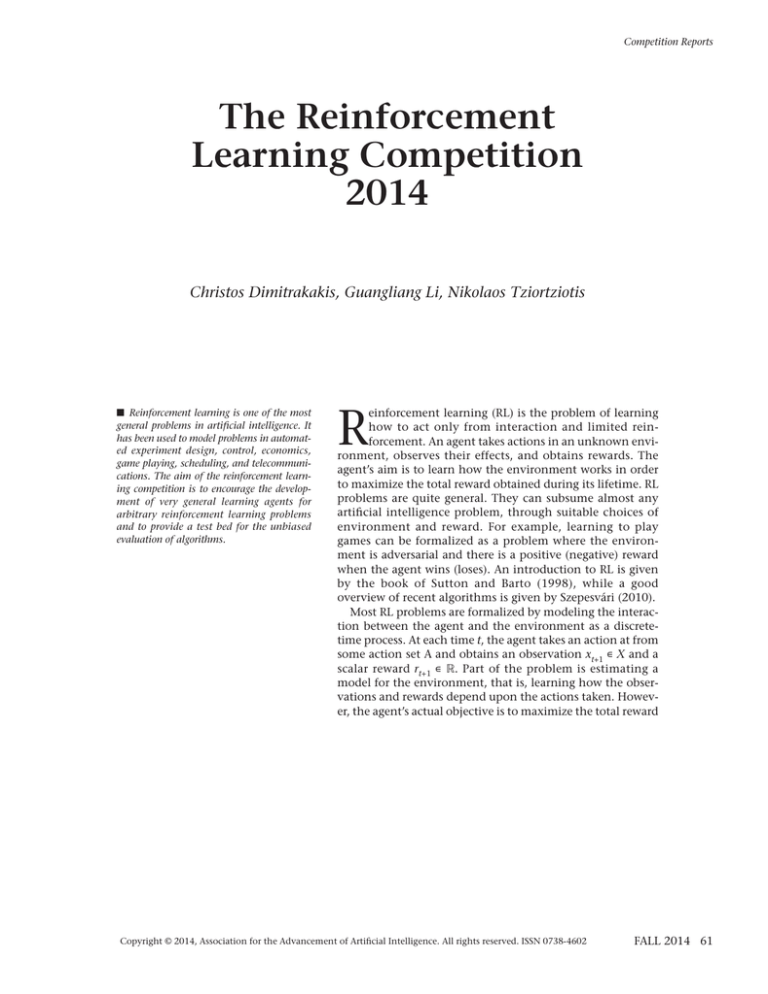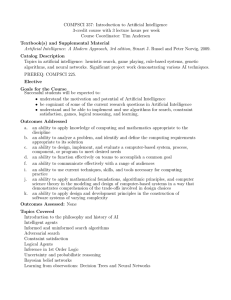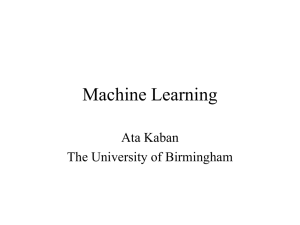
Competition Reports
The Reinforcement
Learning Competition
2014
Christos Dimitrakakis, Guangliang Li, Nikolaos Tziortziotis
n Reinforcement learning is one of the most
general problems in artificial intelligence. It
has been used to model problems in automated experiment design, control, economics,
game playing, scheduling, and telecommunications. The aim of the reinforcement learning competition is to encourage the development of very general learning agents for
arbitrary reinforcement learning problems
and to provide a test bed for the unbiased
evaluation of algorithms.
einforcement learning (RL) is the problem of learning
how to act only from interaction and limited reinforcement. An agent takes actions in an unknown environment, observes their effects, and obtains rewards. The
agent’s aim is to learn how the environment works in order
to maximize the total reward obtained during its lifetime. RL
problems are quite general. They can subsume almost any
artificial intelligence problem, through suitable choices of
environment and reward. For example, learning to play
games can be formalized as a problem where the environment is adversarial and there is a positive (negative) reward
when the agent wins (loses). An introduction to RL is given
by the book of Sutton and Barto (1998), while a good
overview of recent algorithms is given by Szepesvári (2010).
Most RL problems are formalized by modeling the interaction between the agent and the environment as a discretetime process. At each time t, the agent takes an action at from
some action set A and obtains an observation xt+1 ∊ X and a
scalar reward rt+1 ∊ R. Part of the problem is estimating a
model for the environment, that is, learning how the observations and rewards depend upon the actions taken. However, the agent’s actual objective is to maximize the total reward
R
Copyright © 2014, Association for the Advancement of Artificial Intelligence. All rights reserved. ISSN 0738-4602
FALL 2014 61
Competition Reports
Figure 1. History of Reinforcement Learning Competition and Collocated Events.
62
AI MAGAZINE
Competition Reports
T
U = ! rt
t =1
during its lifetime. Thus, it must not waste a lot of
time learning aboutenvironment details that are not
relevant for obtaining rewards. It should properly
balance exploitation of what is already known with
exploration of unknown parts of the environment.
This exploration-exploitation dilemma is at the core
of the reinforcement learning problem, and it is due
to its interactive nature.
Comparisons between different RL algorithms are
inherently difficult. Authors of algorithms may
spend a lot of time tuning them to work well in specific types of domains, even when they are ostensibly
learning from scratch. What is needed is a way to perform unbiased comparisons. This is offered by the RL
competition. While unbiased comparisons for static
data sets are a well-established practice, the interactive nature of RL means that no fixed data sets are
possible. However, the same principle applies to complete environments. A designer can tune algorithms
on a small set of representative environments, and
then use another set of similar, but nonidentical
environments to test them on.
This is the principle used by the reinforcement
learning competition, through the use of generalized
domains. Each domain corresponds to a different
type of problem, such as helicopter control. Training
and testing is performed on specific domain
instances of the problem, for example, helicopters
with different physical characteristics. The competition format ensures an unbiased comparison
between algorithms, that truly tests their ability to
learn. The next section gives an overview of the competition’s history and its evolution to the current format. The goals and format of the upcoming competition are detailed in the 2014 competition section.
History of the Competition
The competition aims to foster development of general RL algorithms and to promote their systematic
comparison. It has generated a set of benchmark
domains and results, which were used as a basis of
comparisons in further work. The competition and
the related open source code have been used in
teaching and research projects (Whiteson, Tanner,
and White 2010) and have greatly increased the
interest and focus in RL by clarifying its objectives
and challenges, making the area more exciting and
enjoyable, especially for novices in the RL community.
The competition history is summarized in figure 1,
starting with a workshop at the 2004 Neural Information Processing Systems (NIPS) conference, organized by Rich Sutton and Michael Littman. This event
discussed a standard set of benchmarks and a series of
competitive events to enhance reinforcement learning research. The next event was held at NIPS 2005,
with more than 30 teams participating. This event
featured a new RL framework (later called RL-Glue)
developed at the University of Alberta. This offers a
language independent API for evaluating agents in
different environments and experimental setups
(Tanner and White 2009). RL-Glue was used by all later competitions and events.
After another event at the International Conference on Machine Learning (ICML) in 2006, organized
by Shie Mannor and Doina Precup, the first annual
RL competition was held at NIPS 2006. This was the
first official competition with prizes and winner certificates. Eight teams participated, and the winners
presented their work at the workshop.
The second annual RL competition was held by
Shimon Whiteson, Brian Tanner, and Adam White in
2008 at an ICML workshop, in which 21 teams participated (Whiteson, Tanner, and White 2010). After
this success, the third reinforcement learning competition was held in 2009 with a joint workshop at
ICML, Uncertainty in Artificial Intelligence (UAI),
and Conference on Learning Theory (COLT). The
competition attracted 51 teams comprising 90 members. Prizes included electronic devices and gift certificates, while travel scholarships were available for
participants to defray the cost of attendance.
The 2008 and 2009 competition had higher levels
of participation than previous events. However, the
competition was not revived until 2013, with an
associated ICML workshop, to ensure its continuing
existence.
Domains
The competition includes domains with various characteristics and complexity to encourage researchers
to develop methods for challenging problems. The
2005 event featured three continuous domains
(Mountain Car, Puddle World, and Cart Pole) and
three discrete domains (Blackjack, Sensor Network,
and Taxi). In addition, there were two triathlon
events, in which the same agent competed on all the
three continuous or discrete domains.
The 2006 competition added the adversarial catmouse domain and octopus arm control. The latter is
a large-scale domain with high-dimensional continuous observation and action spaces (Yekutieli et al.
2005). However, the proliferation of domains meant
that many domains had very few entrants. For that
reason, the total number was reduced steadily, but
new domains were introduced every year. The 2008
competition featured Helicopter Hovering (Bagnell
and Schneider 2001; Ng et al. 2006), Keepaway Soccer (Stone et al. 2006; Stone, Sutton, and Kuhlmann
2005), and Real-Time Strategy. Helicopter Hovering
and Keepaway were high-dimensional domains,
which were problematic for traditional RL methods.
The 2009 competition introduced the classic Acrobot
problem (DeJong and Spong 1994) and the Infinite
FALL 2014 63
Competition Reports
Mario Game. Finally, the 2013 competition introduced the Invasive Species Problem (Muneepeerakul
et al. 2007), a very high-dimensional structured
domain.
Polyathlon domains are a special characteristic of
the RL competition, starting with the triathlon
events of 2006. In those, agents are tested in a series
of tasks, which could be completely unrelated and
are not known in advance. Consequently, entrants
must submit very general agents. They must be able
to learn to act optimally in essentially arbitrary environments, while exploiting whatever structure they
can discover.
Evaluation of Agent Performance
In the competition, the agent performance is based
on the total reward the agent received. At the first
benchmarking event in 2005, there was no separation between training and testing, and consequently
allowed considerable prior knowledge to be used
(Whiteson, Tanner, and White 2010).
To promote agents that really learn, the 2006 event
separated agent evaluation into training and testing
phases. During training, participants were allowed
unlimited runs on a fixed training set of problems.
The testing phase used a different but similar set of
problems. Agents were allowed a period of free exploration in the test set, which did not count toward the
final score. Later events separated this out in an
explicit proving phase, where entrants had a limited
number of attempts to try out their agents in new
environments. The combination of this with a
leaderboard, which compared the results of different
teams, motivated participants to continually
improve their agents throughout the competition.
The 2014 Competition
The organizers of the 2014 competition are Christos
Dimitrakakis (Chalmers University of Technology),
Guangliang Li (University of Amsterdam), and Nikolaos Tziortziotis (University of Ioannina). The competition server will open this fall, and the competition will take place in November–December 2014.
Competitors will have the opportunity to compete in
domains with various characteristics (such as complexity, difficulty, and others) in an unbiased manner. At the end of the competition, authors will be
requested to submit a paper to the competition workshop, collocated with a major conference in the AI
field, present their methods, and receive their prizes.
Competition Format
The competition consists of three main phases: training, proving, and testing. During the first two phases
the participants will have the opportunity to refine
their agents. Only the results of the testing phase will
be taken into account for evaluation. As in the last
four competitions, our evaluation criterion will be
64
AI MAGAZINE
the online performance of the agents: the total
reward collected. As the testing instances will differ
from both the training and proving instances, this
format benefits agents that can learn efficiently
online.
In the training phase, competitors receive a set of
training environments, which are specific instances
of the generalized domain. For the helicopter example, this would mean that the physical characteristics of the helicopter may vary across instances. The
competitors can use the training environments to
make their algorithms as robust as possible. This
local development allows an unlimited number of
attempts.
In the proving phase of the competition, competitors can try their algorithms in preliminary
experiments in new instances on the competition
server. They can thus verify that their algorithms can
generalize well outside the training set. The performance of various competitors in this phase is visible in a leaderboard, and helps to ensure that competitors can perform well. The number of attempts
per week in this phase is limited. However, the scores
during this phase do not count toward the final competition score.
The final competition phase is testing. During this
phase, competitors test their algorithms in new
domain instances on the competition server. The
score during this phase is used for the agent’s evaluation. The scores across different domains are treated independently, and every team is allowed to compete in multiple domains.
The competition platform is based on the RLGlue1 API. This is a standard interface for connecting
RL agents and environments and allows participants
to create their agents in their language of choice.
Apart from the training phase, participants connect
to the central competition server over the Internet,
to obtain new environments and report results. During proving and testing, the competition software
updates the leaderboards on the web. In this way,
participants can see how their agents compare with
others.
Getting Involved.
We are actively looking for volunteers to help with
various aspects of the competition. First, we welcome
the donation of prizes to foster additional involvement in the competition. These can include travel
scholarships, monetary prizes, or trophies. Second,
we would like to invite volunteers to help with technical issues. To ensure the continuity of the competition, we request enthusiastic individuals that can
help with the technical side of the competition for
2014. Third, we request submissions of new
domains. You are welcome to email us your suggestions. Of particular interest for the competition this
year will be (1) adversarial problems and (2) games
problems with changing tasks. Finally, and most
Competition Reports
CALL FOR PAPERS
The Twenty Eighth International Conference on Industrial, Engineering
& Other Applications of Applied Intelligent Systems
(IEA/AIE-2015)
Seoul, South Korea – June 10 - 12, 2015
IEA/AIE-2015 Conference website:
http://www.ieaaie2015.org/
Sponsored by: International Society of Applied Intelligence (ISAI) and In Cooperation with: Association for the Advancement of Artificial Intelligence (AAAI); Association for Computing Machinery (ACM/SIGART); Austrian Association for Artificial Intelligence (ÖGAI); Catalan Association for Artificial Intelligence (ACIA); Delft University of Technology; International
Neural Network Society (INNS); Italian Artificial Intelligence Association (AI*IA); Japanese Society for Artificial Intelligence
(JSAI); Lithuanian Computer Society-Artificial Intelligence Section (LIKS-AIS); Spanish Society for Artificial Intelligence
(AEPIA); Society for the Study of Artificial Intelligence and the Simulation of Behaviour (AISB); Taiwanese Association for
Artificial Intelligence (TAAI); Taiwanese Association for Consumer Electronics (TACE); Korea Business Intelligence and Data
Mining Society; Texas State University-San Marcos; VU University Amsterdam.
IEA/AIE 2015 continues the tradition of emphasizing applications of applied intelligent systems to solve real-life problems
in all areas including engineering, science, industry, automation & robotics, business & finance, medicine and biomedicine,
bioinformatics, cyberspace, and human-machine interactions. IEA/AIE-2015 will include oral presentations, invited speakers, and special sessions. Paper submission is required by November 23, 2014. Submission instructions and additional
details may be obtained from the website http://www.ieaaie2015.org/.
importantly, we encourage your participation with
agent submissions. We hope to have a vibrant and
exciting 2014 competition.
References
Bagnell, J. A., and Schneider, J. G. 2001. Autonomous Helicopter Control Using Reinforcement Learning Policy Search
Methods. In Proceedings of the IEEE International Conference
on Robotics and Automation, volume 2, 1615–1620. Piscataway, NJ: Institute for Electrical and Electronics Engineers.
DeJong, G., and Spong, M. W. 1994. Swinging Up the Acrobot: An Example of Intelligent Control. In Proceedings of the
American Control Conference, volume 2, 2158–2162. Piscataway, NJ: Institute for Electrical and Electronics Engineers.
Muneepeerakul, R.; Weitz, J. S.; Levin, S. A.; Rinaldo, A.; and
Rodriguez-Iturbe, I. 2007. A Neutral Metapopulation Model
of Biodiversity in River Networks. Journal of Theoretical Biology 245(2): 351–363. dx.doi.org/10.1016/j.jtbi.2006.10.005
Ng, A. Y.; Coates, A.; Diel, M.; Ganapathi, V.; Schulte, J.; Tse,
B.; Berger, E.; and Liang, E. 2006. Autonomous Inverted Helicopter Flight Via Reinforcement Learning. In Experimental
Robotics IX, 363–372. Berlin: Springer.
Stone, P.; Kuhlmann, G.; Taylor, M. E.; and Liu, Y. 2006.
Keepaway Soccer: From Machine Learning Testbed to
Benchmark, 93–105. In RoboCup 2005: Robot Soccer World
Cup IX. Berlin: Springer.
Stone, P.; Sutton, R. S.; and Kuhlmann, G. 2005. Reinforcement Learning for Robocup Soccer Keepaway. Adaptive
Behavior 13(3): 165–188. dx.doi.org/10.1016/j.jtbi.2006.
10.005
Sutton, R. S., and Barto, A. G. 1998. Reinforcement Learning:
An Introduction. Cambridge, MA: The MIT Press.
Szepesvári, C. 2010. Algorithms for Reinforcement Learning. In Synthesis Lectures on Artificial Intelligence and Machine
Learning, volume 4. San Rafael, CA: Morgan & Claypool
Publishers.
Tanner, B., and White, A. 2009. RL-Glue: Language-Independent Software for Reinforcement-Learning Experiments. The Journal of Machine Learning Research 10: 2133–
2136.
Whiteson, S.; Tanner, B.; and White, A. 2010. Report on the
2008 Reinforcement Learning Competition. AI Magazine
31(2): 81.
Yekutieli, Y.; Sagiv-Zohar, R.; Aharonov, R.; Engel, Y.;
Hochner, B.; and Flash, T. 2005. Dynamic Model of the
Octopus Arm. I. Biomechanics of the Octopus Reaching
Movement. Journal of Neurophysiology 94(2): 1443–1458.
dx.doi.org/10.1152/jn.00684.2004
Christos Dimitrakakis is a researcher and lecturer at
Chalmers University of Technology. His research interests
include decision theory and reinforcement learning, security, and privacy. He obtained his Ph.D. in 2006 from EPFL,
Switzerland.
Guangliang Li is a Ph.D. candidate at the University of
Amsterdam. His research focuses on reinforcement learning
and human computer interaction.
Nikolaos Tziortziotis is a Ph.D. candidate at University of
Ioannina. His research interests include machine learning
and reinforcement learning.
FALL 2014 65






